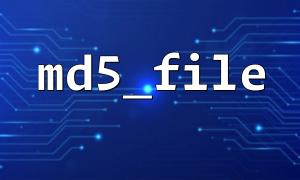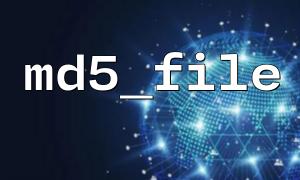In the fields of web security and data integrity protection, developers often use the md5_file() function to detect file tampering. This function calculates the MD5 hash of a given file, providing a "digital fingerprint," which, in theory, can be used to confirm whether a file has changed after a specific point in time. So, how effective is md5_file() in real-world applications? Is its security sufficient? And what are its limitations?
The md5_file() function in PHP is very simple to use. It takes a file path as input and returns the MD5 hash of the file's contents. For example:
$hash = md5_file('/var/www/html/upload/manual.pdf');
echo "File fingerprint: $hash";
By comparing the current MD5 value with the previously stored hash, developers can determine whether the file has changed. This is an efficient and convenient method for scenarios like content delivery, configuration file security monitoring, and file upload validation.
Fast Calculation: The MD5 algorithm is very fast and adds almost no load to the system, making it suitable for frequent calculations.
Easy to Implement: No complex configuration is required, as native PHP supports it.
Strong Compatibility: Almost all programming languages have corresponding MD5 functions, enabling cross-platform comparison of hash values.
For example, if you deploy an automatic file verification system that periodically scans critical configuration files on the server and records their MD5 hashes, it can help detect accidental modifications or malicious tampering:
$expectedHash = 'd41d8cd98f00b204e9800998ecf8427e'; // Pre-recorded hash
$currentHash = md5_file('/etc/nginx/nginx.conf');
<p>if ($expectedHash !== $currentHash) {<br>
error_log("The configuration file may have been modified!");<br>
}<br>
It cannot completely prevent tampering; it can only detect file changes.
md5_file() does not have anti-tampering capabilities; it is merely a passive detection tool. If an attacker has already infiltrated the system and tampered with files, they may also update the MD5 hash records at the same time, rendering the comparison mechanism ineffective.
Furthermore, MD5 has been shown to be vulnerable to collision attacks. An attacker can create two different files that have the same MD5 value. This means that if the attacker is skilled enough, they could bypass the MD5-based integrity check. For example, they might upload a malicious file that appears normal but has the same MD5 value as a trusted file, thereby bypassing the validation logic:
$trustedHash = md5_file('https://m66.net/uploads/contract_original.pdf');
$uploadedFileHash = md5_file($_FILES['contract']['tmp_name']);
<p>if ($uploadedFileHash === $trustedHash) {<br>
move_uploaded_file($_FILES['contract']['tmp_name'], '/var/www/uploads/');<br>
echo "File upload successful";<br>
}<br>
In this logic, if the attacker can forge a file with the same MD5 value, they can easily deceive the system.
Collision Risk: MD5 has been extensively studied, and feasible collision attacks exist.
Non-Reversible Is Not Encryption: MD5 is a hash algorithm, not an encryption function, so the content cannot be restored.
Lack of Source Authentication: MD5 alone cannot verify the source of a file; it cannot prevent legitimate files from being replaced.
Performance Overhead for Large Files: Although relatively fast, there is still a performance cost when dealing with very large files.
Can Be Synchronously Updated: If an attacker has full control over the system, they can simultaneously modify the file and the hash records.
SHA-256 / SHA-512: More secure hash algorithms with an extremely low collision probability.
Digital Signatures: Combine public key mechanisms to sign and verify the file, ensuring its origin and integrity.
File Access Control and Anti-Tampering Systems: Such as Linux's inotify, AIDE, Tripwire, etc.
Centralized Auditing and Log Recording Systems: For easier post-analysis and tracing.
md5_file() still holds practical value in certain lightweight scenarios, especially for projects with limited resources and no need for high-level security protection. However, it is not a "silver bullet" for preventing tampering. As security requirements increase, more secure hash algorithms or additional mechanisms should be introduced for multi-layered protection. Understanding its limitations is the first step in using it correctly.














